From Wikipedia, the free encyclopedia
The Book of Joshua (Hebrew: Sefer Y'hoshua ספר יהושע) is the sixth book in the Hebrew Bible. This book stands as the first in the Former (or First) Prophets covering the history of Israel from the possession of the Promised Land to the Babylonian Captivity. The book of Joshua contains a history of the Israelites from the death of Moses to that of Joshua, and a description of the conquest of the land. Recent archaeological findings have, in some cases supported, and in others raised questions, over the historicity of the account.
[edit] Authorship
The Book of Joshua has been traditionally ascribed to Joshua himself by Talmudic tradition (Bava Batra 15a), medieval Jewish writers and by the Early Church Fathers. During the 18th century, the traditional account began to be questioned. Gerhard von Rad proposed that it continues the JE version of the Torah to form a six-book compilation called the hexateuch. Thus two of the main spliced-together narrative sources within it - Jahwist (J), and Elohist (E) - or at least deriving from sources from the same schools of thought as these. An alternative view was promoted by Martin Noth who suggested that Joshua forms more of a thematic continuity with the books Deuteronomy to Kings to form a Deuteronomic history.[1] In this view, Deuteronomists detached the Joshua section of this at some later point and embedded it within the Deuteronomic history, making a number of minor edits and framing additions (mainly Joshua 1, 21:43, 22:6, and 23).[2]
Currently, there is little consensus on the issue of authorship. Liberal scholars tend to hold that the book had many authors and was a product of the 8th and 7th centuries BC, with retouchings in the exilic period. Conservative scholars, in contrast, tend to hold that the book was written closer to the time of Joshua, though probably not during Joshua's lifetime. They do agree that the book was probably subject to some later limited redactions.[3][4][5][6][7]
According to Israeli archaeologists Israel Finkelstein and Amihai Mazar, "Most scholars of the last generation regard the conquest narratives as a literary work of a much later time designed to create a pan-Israelite national saga".[8]
[edit] Structure
The book essentially consists of three parts:
- The history of the conquest of the land (1-12).
- The allotment of the land to the different tribes, with the appointment of cities of refuge, the provision for the Levites (13-22), and the dismissal of the eastern tribes to their homes. This section has been compared to the Domesday Book of the Norman Conquest (though significantly shorter and not the work of one man).
- The farewell addresses of Joshua, with an account of his death (23, 24).
[edit] Summary of contents
Moses sends out twelve spies from Shittim to explore the city of Jericho. when they return only Caleb and Joshua give good reports, the other ten say the opposite. The Israelites disobeyed God and choose to listen to the ten other spies. They all took rocks and began to stone Caleb and Joshua. For Israel's punishment God made the whole generation who were born in Egypt wander in the wilderness for 40 years. Those born after the Exodus from Egypt could live and go into the Promised Land. The unfaithful Israelites who had come from Egypt would die before entering the Promised Land.
After Moses' death, Joshua, by virtue of his previous appointment as Moses' successor, received from God the command to cross the Jordan River. In execution of this order Joshua issues the requisite instructions to the stewards of the people for the crossing of the Jordan; and he reminds the Reubenites, Gadites, and the half of Manasseh of their pledge given to Moses to help their brethren.
Having re-iterated the duty to follow the mitzvah, Joshua orders the Israelites to set forth, and they leave Shittim. When they reach the Jordan River, Joshua states that the Ark will miraculously cross the Jordan. As soon as the Ark reaches the river, a miracle duly occurs, and the river stops flowing and rapidly dries up, so the priests carrying it halt, allowing the rest of the Israelites to cross as well. In commemoration of the event, Joshua orders two monuments to be erected: one in the river-bed; the other on the western bank, where the Israelites encamp.
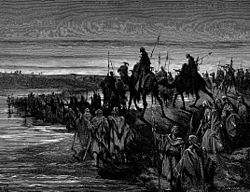
Joshua and the Israelites crossing the Jordan
The Israelites are circumcised at Gibeath-Haaraloth (translating as hill of foreskins). Those who had been born in the desert had not been circumcised. The people are therefore circumcised, and the area is named Gilgal in memory (Gilgal sounds like Gallothi - I have removed, but is more likely to translate as circle of standing stones).
The Israelites then commence with the Battle of Jericho. Placing Jericho under siege, the Israelites circle it once a day for six days, and on the seventh make seven circuits, each time loudly blowing horns and shouting. On the final circuit, the walls cave in, and the inhabitants, except Rahab and her family, are slaughtered. A curse is pronounced against rebuilding the city.
Ai is surveyed and pronounced weak, so the Israelite army sends only a small group to attack them. However they are defeated, causing Joshua and the people to despair. But God announces that the people have sinned: someone has stolen some of the spoils from Jericho which are meant to be for the temple. Consequently the Israelites set out to discover the sinner by casting lots, whittling them down first by tribe (Judah), then clan (Zarhites), then sept (Zabdi), then finally detecting it as Achan. Achan admits having taken a costly Babylonian garment, besides silver and gold, and his confession is verified by the finding of the treasure buried in his tent, so Achan is taken into the valley of Achor, where he and his household are stoned and burned to death.
Afterwards, 30,000 Israelites set an ambush of Ai overnight, and in the morning another Israelite force attack and then feign retreat, drawing the forces of Ai far away from the city. When Joshua raises his lance, the 30,000 men preparing the ambush strike, while Joshua starts attacking again, thus surrounding Ai's forces. The entire city is burned and its inhabitants slaughtered. The king of Ai, however, is taken alive and delivered to Joshua. He is then impaled on a stake for public display before being buried outside the city gates, following Hebrew guidelines for the guilty. (see Deuteronomy 21.23).
Joshua erects an altar on Mount Ebal and makes offerings upon it and carves into it the law of Moses. The people are arranged into two sections, with one facing Ebal and the other facing Gerizim. They each read the blessings and curses specified in Deuteronomy as appropriate.
The Hivites fool the Israelites into thinking them foreigners and gain a non-aggression treaty from the Israelites. Even after its detection, the fraud is not abrogated, though the Hivites are punished by being treated as the lowest social class (referred to via the Hebrew idiom "hewers of wood and drawers of water for the altar of Yhwh").
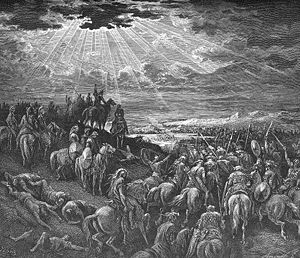
An 1883 depiction of Joshua commanding the sun to stand still in the sky.
Adonizedek, king of Jerusalem, brings about an alliance of the "five kings of the Amorites" (the kings of Hebron, Jarmuth, Lachish, and Eglon, and himself), and they besiege the Hivites in Gibeon, whom they perceive as traitors. The Hivites implore Joshua's help, and so he launches a surprise attack following a night march, causing the Amorites to panic and flee as far as Beth-horon. A poem is quoted from the Book of Jasher, which states that the sun stood still at Gibeon, and the moon in the valley of Ajalon, in order that Joshua could complete the battle. Despite the five kings' cowardly attempt at avoiding retribution by hiding inside a cave, they are discovered and trapped there until their army has been completely obliterated. Afterwards, the kings are brought to Joshua, who first humiliates them, then orders their death and has them impaled for public display. At sunset, the bodies are thrown back into the cave from which they hid, and the entrance sealed.
Jabin, king of Hazor, his army, and his vassals, rendezvous at Merom. Joshua, however, executes a swift attack and is able to defeat them. Pursuing them to a great distance, he hamstrings their horses, burns their chariots, captures Hazor, slaughters its inhabitants, and burns it to the ground. Lesser royal residences are also captured and their inhabitants slaughtered, although the cities on the hill remain.
[edit] Historicity
There is a great deal of debate concerning the historicity of the accounts in Joshua. The archeological evidence here, as with most biblical issues, is widely open to interpretation. As such, scholars hold widely differing views, even over the same facts and evidences.[3][4][5][6][7] Conservative scholars and archeologists see much of the archeological data confirming many of the claims in Joshua, although admit that the data is uncertain in various areas.[3][4][5][6][7] According to Israeli archaeologists Israel Finkelstein and Amihai Mazar, "It is now accepted by all that archaeology in fact contradicts the Biblical account of the Israelite conquest as a discreet historical event led by one leader".[8][9][10][11][12][13]
[edit] Liberal scholars
Liberal scholars note that archaeologists have raised questions about the timing of the overthrow of the two cities Lachish and Hazor, and liberal scholars believe that the current evidence does not support the biblical account that Joshua led campaigns against both cities (Josh. 10:31-32; 11:10-11) since 100 years separate the destruction of Hazor from that of Lachish.[14][15] According to these scholars, archeological evidence shows that many cities that play key roles in the conquest narratives (primarily Jericho, Ai, Hormah, Arad, Jarmuth, Heshbon and Gibeon) were not occupied during Joshua's time(ca. 1200 BCE).[16][17] These sites suffered destruction shortly before 1400 BCE, two centuries before the Israelites came on the scene.[18]
Liberal and conservative scholars both have noted that the region had been in a state of turmoil two centuries before Joshua's time.[3][5][6][7] This poorly understood late Bronze Age collapse of civilization in the eastern Mediterranean was at least partly due to the breakup of the Hittite Empire and the campaigns of the Sea Peoples (who often burnt cities to the ground and sometimes resettled the towns they destroyed). Archeologists have discovered destruction layers in many of these cities that overlap this widespread collapse. It is more plausible, from the point of view of liberal scholars, for this regional collapse to have been responsible for the destruction of the cities, rather than an invasion of Israelites under Joshua's leadership lasting only about five years.[15][19]
In addition, liberal scholars argue that the archaeological evidence shows a smooth cultural continuity in this period, rather than the destruction of one culture (Canaanite) and replacement by another (Israelite), and believe that the Israelites were simply an emergent subculture within Canaanite society.[19] From the point of view of liberal scholars, the author(s) of Joshua combined a series of independent traditions about battles and destruction of various cities at differing times, in order to create a favorable narrative.[20]
They also see a contradiction between the stories of conquest in Joshua and Judges 1. According to Joshua 10:29-40; 11:14-23; 12:7-8; 21:43-45, Joshua conquered the whole land of Canaan, "totally destroyed all who breathed" and "left no survivors". These conquests divided among the tribes in Joshua's lifetime (Joshua 10:40;11:14-23;21:43-45). According to Judges 1 only part of the country was conquered "after the death of Joshua" and the Canaanites were still a group to be reckoned with.[12][21][22]
[edit] Conservative scholars
Conservative scholars[3][4][5][6][7], in contrast, tend to defend the historicity of the book's account, although they are usually open to assumptions that the account is not completely objective.[23][24][25] They note that it is known that during this period waves of migrants, mostly from the north, were coming into Canaan and settling in recently destroyed towns. They point to this, as well as to several indications from the book of Joshua, to argue that while some towns may have experienced invasion earlier, they were by Joshua's time partly repopulated but too small to leave behind much evidence.[4] The book of Joshua, for example, suggests that several of these cities (such as Jericho and Ai) were sparsely populated at the time and in a weakened state. Jericho is believed to have had only a few thousand inhabitants, and the book of Joshua suggests that Jericho's wall was so make-shift that it lacked basic anti-siege equipment (the Israelites paraded outside of the city walls for a week without encountering any resistance). They also note that archeological evidence from Hazor, which appears from Joshua to have been the largest and most important Canaanite city at the time (thus the most likely to leave behind evidence), agrees with the account in Joshua. Hazor has been shown to have been destroyed around 1250 BCE, which by most accounts was the time of Joshua.[4][14][15] Many conservative scholars, such as Richard Hess, believe the archeological evidence to be inconclusive, supporting the account in Joshua in some cases, while failing to do so in others.[4]
Also, they don't see a conflict between Joshua and Judges because Joshua never claims that Israel totally displaced the Canaanites. They also note that Joshua mentions that a large number of Canaanites remained even after the conquest was complete. According to Joshua 13:1, "When Joshua was old and well advanced in years, the LORD said to him, "You are very old, and there are still very large areas of land to be taken over."[3][4][5][6][7] In addition, Joshua is widely viewed to be using hyperbole when describing the campaigns. These scholars hold that this should not be taken as a claim of complete destruction (i.e. a claim that the Israelites "slew all who breathed" before noting "and the rest escaped"). König agrees that the author uses "natural hyperboles". More recently, Younger has compared the accounts of the conquest in Joshua 9-12 to other Near Eastern texts with descriptions of conquests which he argues uses similar hyperbole.[26]
[edit] Ethical issues
One difficulty arises out of the numerous commands from God recorded in the book for the Israelites to destroy people and animals in the land that they are occupying. This is related to the concept of cherem (set apart for God, or set under a ban) in which entire cities (such as Jericho; see Joshua 6:17-19) are recorded as commanded to be devoted to destruction.
Some theologians (including many adherents of liberal theology) see this as an ethically unjustifiable order to commit genocide, which is inconsistent with the overall view in the Hebrew and Christian scriptures of God as a loving, compassionate Creator. They see it as a theological polemic, with the majority of events invented during or after the Babylonian captivity, to encourage faithfulness to the Jewish creed at a time when it was being threatened. For instance, Morton says that Joshua "should be understood as a rite of ancient peoples (Israel among them) whereby within the context of their times, they attempted to please their God (or the gods)".[27]
Others, including many conservative theologians who see the book as a historically accurate account written during or soon after the life of Joshua, explain the cruelty of the Israelites as God's way of making an example of nations that engaged in abhorrent practices. Although the book gives no explicit justification for the commands to kill, Deuteronomy 9:4 indicates that this is on account of the "wickedness of those nations". Some theologians have pointed to evidence of practices such as child sacrifice, although others argue that it may have been polemic invented at a later date in order to justify the act of extermination.[28] Hence they believe that the message of Joshua was intended not only for the surrounding nations, but for the Israelites as well (e.g. the stoning of Achan due to his transgression of the cherem).
A Christian alternative viewpoint is to cite progressive revelation in which God reveals himself partially to Joshua and the Jews, but (in due time) fully through Jesus Christ.[29] Proponents of this view argue that the description of war in the book of Joshua was culturally conditioned. For instance, Chapman suggests that the accounts of war and genocide are "the gradual process by which God works in the history of a particular people for whom war is an essential part of religion and culture".[30] The Mennonite scholar John Howard Yoder suggests that the concept of cherem was unique in relation to the morality of the time not in its violence, but in ensuring that "war does not become a source of immediate enrichment through plunder",[31] and hence was the beginning of a trajectory that would lead ultimately to the teaching of nonviolence.
[edit] See also
- ^ John van Seters (2006), The edited Bible: the curious history of the "editor" in biblical criticims, pp. 260-269
- ^ Ronald F. Youngblood, F. F. Bruce, R. K. Harrison and Thomas Nelson Publishers, “Joshua, Book of,” in, Nelson's New Illustrated Bible Dictionary, Rev. Ed. of: Nelson's Illustrated Bible Dictionary.; Includes Index. (Nashville: Thomas Nelson, 1995).
- ^ a b c d e f "Introduction to the Old Testament", chapter on Joshua, by T. Longman and R. Dillard, Zondervan Books (2006)
- ^ a b c d e f g h "Joshua, an Introduction and Commentary, by Richard Hess, Inter-Varsity press (1996)
- ^ a b c d e f "The Book of Joshua", Marten Woudstra, Eerdmans Publishing Co, (1981)
- ^ a b c d e f "World Biblical Commentary", Volume 7-Joshua, by Trent Butler, Word Books, 1983
- ^ a b c d e f "Anchor Bible", chapter on Joshua, by Robert Boling, Doubleday & Co. (1982)
- ^ a b The quest for the historical Israel: debating archaeology and the history of early Israel : invited lectures delivered at the Sixth Biennial Colloquium of the International Institute for Secular Humanistic Judaism, Detroit, October 2005, Israel Finkelstein, Amihai Mazar, Brian B. Schmidt, p. 62
- ^ Who Were the Early Israelites and Where Did They Come From? William G. Dever, Wm. B. Eerdmans Publishing Company, 2006
- ^ The biblical world, Volume 2, John Barton, 45, 2004
- ^ How to read the Bible, 2005, Marc Zvi Brettler, pp. 95-99
- ^ a b Biblical peoples and ethnicity: an archaeological study of Egyptians, Ann E. Killebrew, pp. 152-154, 2005
- ^ The Oxford guide to people and places of the Bible, Bruce M. Metzger, Michael Coogan, P. Kyle McCarter, p. 39
- ^ a b Joshua, Judges, and Ruth, Carolyn Pressler, pp. 74-75
- ^ a b c According to Joshua 14:7-10;10:40;21:43-45, it took Joshua five years to conquer the whole land of Canaan
- ^ Mercer Dictionary of the Bible, 1998, p. 166
- ^ The quest for the historical Israel: debating archaeology and the history of early Israel, Israel Finkelstein, Amihai Mazar, Brian B. Schmidt, p. 61, 2005
- ^ Mercer Dictionary of the Bible, 1990, p. 167
- ^ a b Israel Finkelstein, The Bible Unearthed
- ^ Sturgis, Matthew (2001). It Ain't Necessarily So. Headline Publishing Group. ISBN 0747245061.
- ^ International Standard Bible Encyclopedia: E-J, Geoffrey W. Bromiley, p. 1136
- ^ The Old Testament world, By John Rogerson, Philip R. Davies, 1989, p. 358
- ^ E. König, "Judges, Book of," in: A Dictionary of the Bible, ed. James Hastings, 1898
- ^ Kaufmann, Yehezkel (1953). The biblical account of the conquest of Canaan. Magnes Press.
- ^ orr, James (1906). The Problem of the Old Testament Considered with Reference to Recent Criticism. Charles Scribner.
- ^ K. Lawson Younger Jr. (1990). Ancient Conquest Accounts. A Study in Ancient Near Eastern and Biblical History Writing. JSOT Supplement 98.
- ^ Morton, pp. 324-325
- ^ John, Day (2002). Yahweh and the gods and goddesses of Canaan. Sheffield Academic Press. ISBN 1-85075-986-3.
- ^ Dodd, C.H. (1952). The authority of the bible. Nisbet & Co..
- ^ Colin Chapman, "Holy War", in Zondervan Handbook to the Bible (1999), ed. David Alexander
- ^ Yoder, John Howard. (1971). "If Abraham Is Our Father." In The Original Revolution: Essays on Christian Pacifism. Wipf and Stock.
[edit] References
- Morton, William H. Joshua. The Broadman Bible Commentary, Vol. 2. Ed. Clifton J. Allen, et al. Nashville: Broadman Press, 1970.
- Halley, Henry H. Halley's Bible Handbook. Grand Rapids: Zondervan Publishing House, 1927, 1965.
- Mazar, Amihai. The Archaeology of the land of the Bible. New York: Doubleday, 1990.
- Anati, Emmanuel. The Time of Exodus In the Light of Archaeological Testimony, Epigraphy and Palaeoclimate. Har Karkom, a guide to major sites, Capo di Ponte [Edizioni del Centro], 2005.
[edit] External links
[edit] Translations
This article incorporates text from Easton's Bible Dictionary (1897), a publication now in the public domain. This article incorporates text from the 1901–1906 Jewish Encyclopedia, a publication now in the public domain.

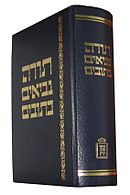



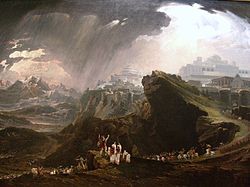
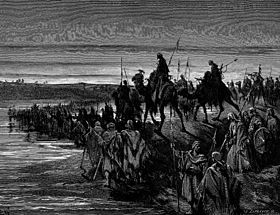
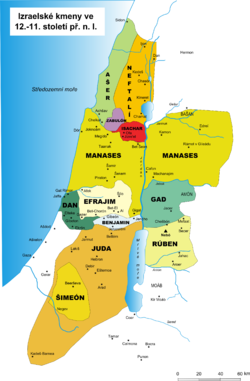
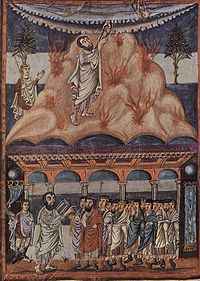
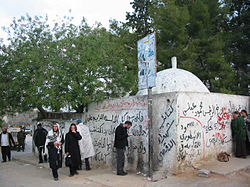
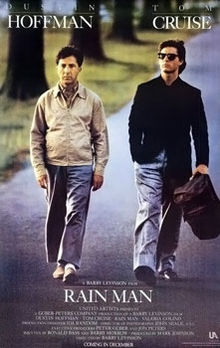


 es una progresión geométrica con razón igual a 3, porque:
es una progresión geométrica con razón igual a 3, porque:
 el término en cuestión,
el término en cuestión,  el primer término y
el primer término y  la razón:
la razón:




 en la definición.
en la definición.




 tiende hacia 0, de modo que:
tiende hacia 0, de modo que:
